AT40 = 25.6% of stocks are trading above their respective 40-day moving averages (DMAs)
AT200 = 37.5% of stocks are trading above their respective 200DMAs (2-year closing low)
VIX = 24.9
Short-term Trading Call: neutral
Commentary
On Friday, President Trump characterized the pre-Trump stock market as something “from another planet.” Surely he meant the last two months of action must be from another planet?

{And THIS is the exact time the stock market could use some cheerleading!}
It was a manic week that featured some bursts of optimism intraday, but sellers prevailed almost every single time. The S&P 500 (via SPDR S&P 500 (NYSE:SPY)) sold off 4 of 5 days and 8 of the last 10. On Friday, it lost 2.1% and pushed right to its 200-day moving average.

The S&P 500 has sold off nearly non-stop since reaching its last peak on the heels of the March jobs report. Friday’s close came right on top of 200DMA support and nearly coincides with the February oversold low.
The S&P 500 is at one of its more important and critical junctures since perhaps the early 2016 sell-off or even the sell-off just ahead of the 2016 Presidential election. The index is at coinciding support from the February closing low and its 200-day moving average (DMA). However, unlike the February low, AT40 (T2108), the percentage of stocks trading above their respective 40DMAs, is NOT yet oversold (below 20%). AT40 closed the day at 25.6% and is far above where it traded during the February trough.

At 25.6%, AT40 (T2108) closed in oversold conditions. For now, my favorite technical indicator is trending up from the February nadir with higher highs and higher lows.
The S&P 500 could fall a LOT further from Friday’s close before reaching another trading bottom. In this scenario, the S&P 500 would be in official bear territory where rallies get sold until the index closes above its 200DMA.
On the optimistic side, if the S&P 500 can somehow survive this latest test of support, a subsequent bounce will come from a stronger point than the last two bounces. Moreover, the S&P 500 is well below its lower-Bollinger Band (BB) and is thus over-stretched. The lower the index stretches below its lower-BB, the more likely it will bounce back regardless of AT40’s level. I chose the more optimistic side when I decided to add to my SPY shares ahead of the 200DMA test.
Either way, trading will be subject to more churn and sharp reversals. I am maintaining my neutral short-term trading call in order to stay braced for the potentially violent trading action. I am planning to do mostly hedged trading with calls and puts that should pay off very well if/once the market moves a lot in a particular direction. I will also be prone to take profits quickly on these trades.
The NASDAQ and the PowerShares QQQ ETF (NASDAQ:QQQ) lost 2.4% and 2.6% respectively and each closed well below its lower-Bollinger Band (BB). Unlike the S&P 500, both indices are still well above critical tests of the February low or the 200DMA.

The NASDAQ has experienced near relentless selling since a bearish-engulfing pattern capped off its all-time high.

The PowerShares QQQ ETF (QQQ) closed at a 6-week low and well below its lower-BB. Since its all-time high on March 12th, QQQ has registered only ONE (minimal) up day.
Small-caps are no longer out-performing to any degree that matters. The iShares Russell 2000 ETF (NYSE:IWM) lost 2.2% and looks ready to slide right past the March low on its way to a rendezvous with 200DMA support.
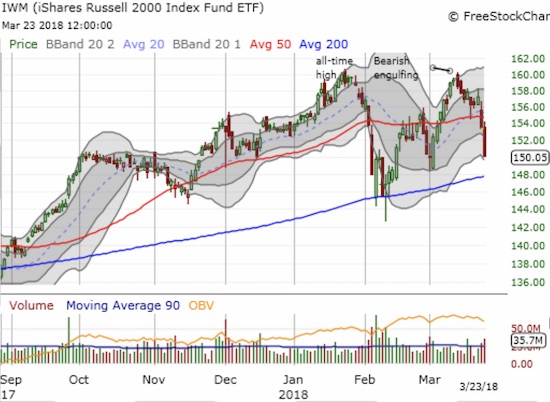
The iShares Russell 2000 ETF (IWM) confirmed its 50DMA breakdown with Friday’s 2.2% loss on high trading volume.
Financials are also experiencing a very critical test.

The Financial Select Sector SPDR ETF (NYSE:XLF) closed at a 4-month low and is set-up with a precarious test of 200DMA support.
AT200 (T2107), the percentage of stocks trading above their respective 200DMAs, is tempering my optimism. This indicator closed at 37.5%, its lowest close in two years. This breakdown implies the longer-term prospects for the market have deteriorated. A lot of long-term damage continues to occur to stocks. This damage is likely exhausting investors who keep betting on longer-term trends only to see positions take fresh dives. Note well that AT200 has trended downward since its late 2016 peak – the rally in the stock market is slowly but surely leaving behind more and more stocks. The chart below is a weekly view…

AT200 (T2107) registered its lowest close in two years. This indicator is spending far too much time under 50%; many stocks are suffering sustained damages to longer-term uptrends.
The volatility index, the VIX, rose 57.4% for the week. The Federal Reserve’s rate hike was in the middle of this run-up. At one point, the VIX erased all its gains for the week. I shorted iPath S&P 500 VIX ST Futures ETN (NYSE:VXX) ahead of the Fed anticipating a post-Fed volatility implosion. With the VIX plunging ahead of the Fed, I figured there was too much risk of the opposite of my expectations, so I took my profits. As the VIX soared post-Fed, I re-accumulated a new short position. This time, I am anticipating a volatility implosion after this latest sell-off ends.
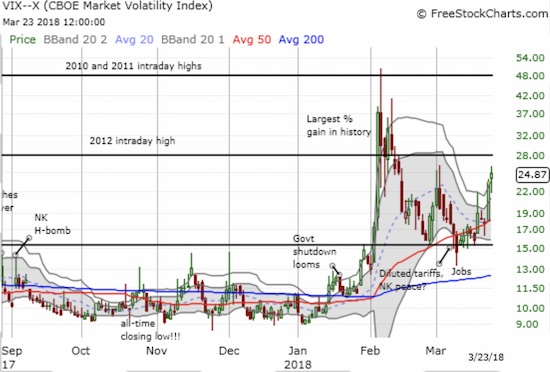
The volatility index, the VIX, bounced first off its 15.35 pivot and now its 50DMA. The VIX now trades at a 6-week high.
CHART REVIEWS
Chipotle Mexican Grill (NYSE:CMG)
CMG had a promising week until Friday. The stock broke out from its 1-month consolidation range and closed above its downtrending 200DMA. On Thursday, the stock even well out-performed the market. I was able to flip a call option on that move. On Friday, I went back to work assuming the 200DMA would hold as support. Instead, sellers snuffed out CMG’s breakout and submerged under its 200DMA once again. I will now be watching out for a false breakout that launches a fresh wave of selling. A breakdown below the 50DMA will be very bearish under these circumstances.
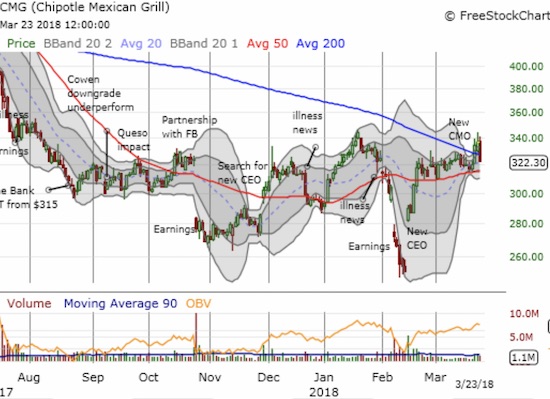
Chipotle Mexican Grill (CMG) broke out on news of a new CMO but on Friday sellers reversed the entire breakout. CMG closed below its 200DMA and put a 50DMA test into play.
Cboe Global Markets (NASDAQ:CBOE)
I still think CBOE is the best way to trade volatility, that is the trade in volatility products. So I consider this current pullback to be a golden opportunity to grow a position. While I am playing for a hold of 200DMA support, I am keeping my stop wide by holding it underneath the post-earnings low.

Cboe Global Markets (CBOE) is joining other financials in a critical test of 200DMA support. The current pullback confirmed 50DMA resistance after a false breakout.
Caterpillar (NYSE:CAT)
CAT filled its roll as a hedge on bullishness. CAT closed at a 3+ month closing low. The stock looks poised to drop all the way to 200DMA support after confirming resistance at its 50DMA with what is called a “rounded top.” The pattern is almost like a mini head and shoulders top. Needless to say, I did not cover my CAT short last week…

The momentum in Caterpillar (CAT) has come to a halt with an ominous topping pattern. A test of 200DMA support is in play.
Boeing (NYSE:BA)
CAT is not the only industrial stock in trouble. I see a LOT of charts like CAT’s and like that of Boeing (BA). BA is a highly loved stock so its fate is very important. The bullish story is well-known and the company’s order book is overflowing with profits for as far as the eye can see. So if sellers are willing to take down BA, they will surely exhibit no mercy on the scores of lesser stocks in the market! On Friday, buyers tried again to defend BA with a sharp out-performance. Buyers took the stock up as much as 2% or so succumbing to sellers. I took this opportunity to get a better price on adding BA to my list of shorts as a hedge against bullish positions. BA ended the day with a 0.4% gain, well ahead of the closes of the major indices. The bulls remain hopeful…

The end of momentum for Boeing (BA) represents a wide area of consolidation. The stock closed at a 2-month low that confirmed 50DMA resistance. A continuation of selling to 200DMA support would erase the breakout from November.
Walmart (NYSE:WMT)
WMT closed at a 5+ month low and confirmed a breakdown below its 200DMA. The stock is 22.3% off its all-time high and officially in bear territory. This move puts an exclamation point on the end of my 2018 trading theme for retail stocks.
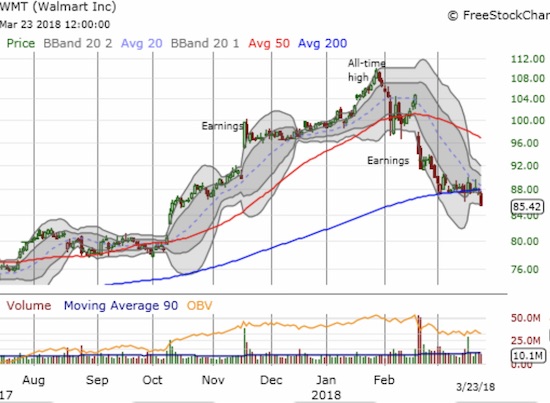
Walmart (WMT) confirmed a very bearish breakdown below its 200DMA. A close above $90 or $91 would restore the upside potential in the stock.
“Above the 40” uses the percentage of stocks trading above their respective 40-day moving averages (DMAs) to assess the technical health of the stock market and to identify extremes in market sentiment that are likely to reverse. Abbreviated as AT40, Above the 40 is an alternative label for “T2108” which was created by Worden. Learn more about T2108 on my T2108 Resource Page. AT200, or T2107, measures the percentage of stocks trading above their respective 200DMAs.
Active AT40 (T2108) periods: Day #26 over 20% (overperiod), Day #1 under 30% (underperiod ending 13 days over 30%), Day #2 under 40%), Day #9 under 50%, Day #34 under 60%, Day #40 under 70%
Daily AT40 (T2108)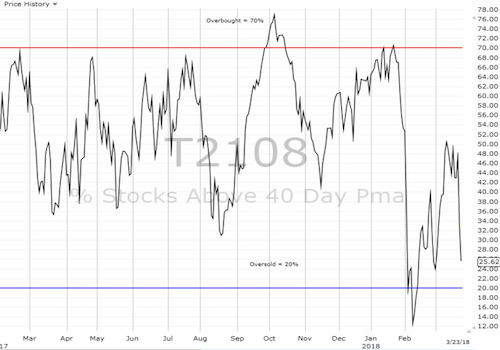
Black line: AT40 (T2108) (% measured on the right)
Red line: Overbought threshold (70%); Blue line: Oversold threshold (20%)
Weekly AT40 (T2108)
The charts above are my LATEST updates independent of the date of this given AT40 post. For my latest AT40 post click here.
Be careful out there!
Additional disclosure: long CMG calls, long BA put, short CAT, long SPY shares, long CBOE
*Charting notes: FreeStockCharts.com uses midnight U.S. Eastern time as the close for currencies. Stock prices are not adjusted for dividends.
